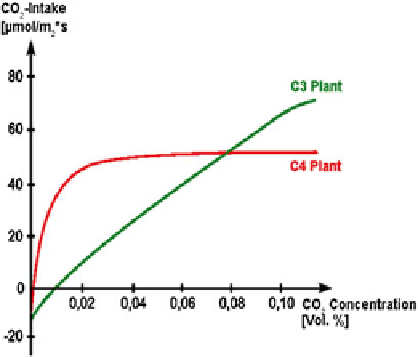Agriculture Reference
In-Depth Information
acacia and rubber vine (
Cryptostegia grandi-
fl ora
) to move into drier habitats (Kriticos et al.
2003
).
Vines respond strongly to higher CO
2
levels
(Gallagher et al.
2006
), and there are many highly
damaging invasive vines (cat's claw
Macfadyena
unguis-cati
and rubber vine) that could benefi t.
Higher CO
2
levels are likely to reduce the
effectiveness of glyphosate, the main chemical
used to control environmental weeds in Australia
(Ziska and Goins
2006
; Ziska and Runion
2007
).
However, since climatic change, especially
increased CO
2
affects C3 and C4 plants differ-
ently, and different combinations must be investi-
gated separately:
• C4 weeds in C3 crops
• C3 weeds in C3 crops
• C3 weeds in C4 crops
• C4 weeds in C4 crops
When solely looking at the benefi t of elevated
CO
2
, it would be possible to argue that C4 weeds
such as barnyard grass (
Echinochloa crus-galli
)
and redroot pigweed (
Amaranthus retrofl exus
),
which do not react to elevated CO
2
with more
biomass production, would be less competitive
than C3 crops which grow better under increased
CO
2
and vice versa; in C4 crops like millets, sor-
ghum, maize, and sugarcane, C4 weeds may
become less competitive than C3 weeds.
Fig. 10.1
Comparison of CO
2
intake of C3 and C4 plants
in relation to atmospheric CO
2
concentrations. At current
CO
2
levels (380 ppm), CO
2
saturation in C4 plants is
achieved
ameliorated at elevated CO
2
as a result of even
lower stomatal conductance. Therefore, unlike
C3 crops for which there is a direct enhancement
of photosynthesis by elevated CO
2
, C4 crops will
only benefi t from elevated CO
2
in times and
places of drought stress. Figure
10.1
shows the
different responses of C3 in comparison to C4
plants to CO
2
increase. CAM plants react to ele-
vated CO
2
similar to C3 plants with enhanced
growth, if water supply is suffi cient. If not, they
will respond like C4 plants.
C3 weeds (using one of two types of photo-
synthetic pathway, which responds to higher lev-
els of CO
2
) such as parthenium (
Parthenium
hysterophorus
) may grow more rapidly under
higher carbon dioxide levels and become more
competitive (McFadyen
2008
; Poorter and Navas
2003
).
CO
2
can affect plant and leaf size, seed size
and production, the nutritiousness of leaves to
herbivores, plant toxicity, and pollen production.
Nitrogen-fi xing weeds, such as brooms, gorse,
and acacias, may especially benefi t because
growth stimulated by CO
2
will not be constrained
by low nitrogen levels (Poorter and Navas
2003
).
Under high CO
2
, C3 plants are likely to
become more water effi cient (Ghannoum et al.
2007
), potentially allowing weeds such as prickly
10.3.1
C4 Weeds in C3 Crops
Among 14 of the world's worst weeds are C4
plants, while around 76 % of the harvested crop
area in 2000 was grown with C3 crops (Monfreda
et al.
2008
). If the hypothesis is right that C3
crops would benefi t more from elevated CO
2
than
C4 weeds, losses due to C4 weeds might decrease.
In the early 1980s, experiments were conducted
to prove this kind of hypothesis (Patterson and
Flint
1990
), and basically, the hypothesis was
supported (Coleman and Bazzaz
1992
; Ziska
2003
). However, more research has been done
manipulating CO
2
concentrations alone.
Temperature increase or drought in combination
with elevated CO
2
was less investigated (Bunce
and Ziska
2000
). When including temperature

Search WWH ::

Custom Search